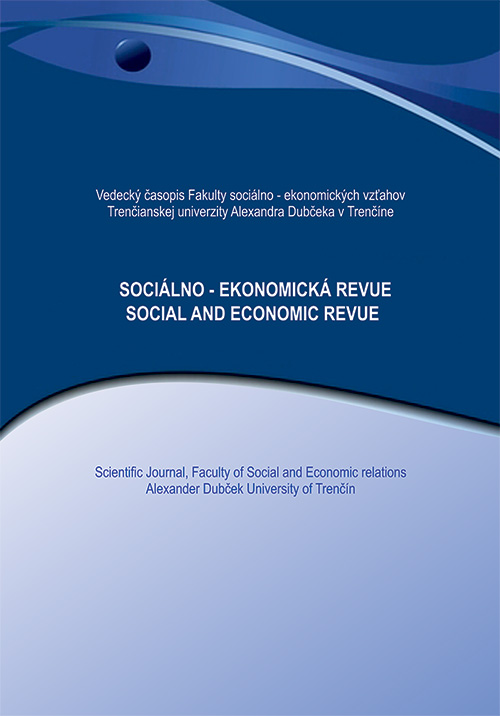CHANGES IN THE LABOUR MARKET IN THE REGIONS OF SLOVAKIA
Workforce requirements change under the influence of changes in the achieved level of human knowledge in the organization of work and work procedures. These changes are constantly taking place, differing in nature and pace. At present, the rapid pace of these changes is characteristic. This is caused by automation, digitization, and robotics, which penetrate all spheres of society. Knowing the changes in the labour market in regions, is important for the development of society. The aim of the paper is to comprehensively evaluate changes in the labor market in the regions of Slovakia, using multidimensional statistical methods.
Vydanie: 2021/1 Strany: 16-24 Klasifikácia JEL: L63, J21, R11
DOI: https://doi.org/10.52665/ser20210102
Kľúčové slová: labour market, labour market indicators, Composite Indicator, multivariate statistical methods
Sekcia:
Kontakty:
RNDr. Dana Jašková, PhD.,
Department of Economics and Economics
Faculty of Social and Economic Relations
Alexander Dubček University in Trenčín
Študentská 3, 911 50 Trenčín,
dana.jaskova@tnuni.sk
Literatúra:
Berger, R. (2016). Skill Development for Industry 4.0. BRICS Business Council. India edition.
Eamets, R., Jaakson, K. (2014). Labour market flexibility and spatial mobility. International Journal of Manpower. Vol. 35. No. 6, pp. 746 –752.
Epifani, P., Gancia, G. A. (2005). Trade, migration and regional unemployment. Regional Science and Urban Economics. Vol. 35, pp. 625 –644.
Havierniková, K., Kráľová, K. (2019) Analysis of selected issues related to human resources and Industry 4.0 in case of engagement into cluster cooperation on example to technological SME. The impact of Industry 4.0 on job creation. Trenčín: TnUAD, 81-88.
Hoellthaler, G., Braunreuther, S., Reinhart, G. (2018). Digital Lean Production. An Approach to Identify Potentials for the Migration to a Digitalized Production System in SMEs from a Lean Perspective. Procedia CIRP, 67, 522–527. [online]. [acc.2021-02-2]. Retrieved from: https://doi.org/10.1016/J.PROCIR.2017.12.255
ILO (2016). Key Indicators of the Labour Market, Ninth edition. Geneva, International Labour Office. Retrieved from: https://www.ilo.org
Minařík, K., Borůvková, J., Vystrčil, M. (2013). Analýzy v regionálním rozvoji. Professional Publishing, Příbram
Nardo M., Saisana M., Saltelli A., Tarantola S., Hoffman A., Giovannini E. (2005). Handbook on constructing composite indicators: methodology and user guide. OECD Statistics Working Paper, Paris
Neufeind, M., O’Reilly, J., Ranft, F. (2018). Work in the digital age. Challenges of the Fourth Industrial Revolution. Rowman & Littlefield International Ltd. Policy Network, London
Niebuhr, A., Granato, N., Haas, A., Hamann, S. (2009). Does labour mobility reduce disparities between regional labour markets in Germany? IAB –Discussion Paper 15/2009. Nuremberg: Institute for Employment Research of the Federal Employment Agency.
OECD (2018a), OECD Regulatory Policy Outlook 2018. OECD Publishing, Paris. Retrieved from: https://www.oecd.org/governance/oecd-regulatory-policy-outlook-2018-9789264303072-en.htm
OECD (2019). OECD Employment Outlook 2019: The Future of Work. OECD Publishing, Paris. Retrieved from: https://doi.org/10.1787/9ee00155-en
Saisana M., Tarantola, S. (2002). State-of-the-art report on current methodologies and practices for composite indicator development, EUR 20408 EN, European Commission-JRC: Italy
Suedekum, J. (2004). Increasing returns and spatial unemployment disparities. Papers in Regional Science, Vollume 84 isssue 2, pp. 159 –181
Schwab, K. (2015). The Fourth Industrial Revolution: What It Means and How to Respond. Retrieved from https://www.foreignaffairs.com/articles/2015-12-12/fourth-industrial-revolution.
Štefánik, M. [et al.] (2018). Labour market in Slovakia 2019+. ŠEVT, Bratislava 2018.
Vuksannovič, D., Ugarak, J., Korčok, D. (2016). Industry 4.0: The future concepts and new visions of factory of the future development. International scientific conference on ICT and e.business related research, SINTEZA, pp. 293 – 298.
Xu, M. [et al.]. (2018) The Fourth Industrial Revolution: Opportunities and Challenges. International Journal of Financial Research Vol. 9, No. 2. Retrieved from: http://ijfr.sciedupress.com
DataCube (2021). Statistics [online]. [cit.2021-03-01]. Available at: http://datacube.statistics.sk.
https://www.trendyprace.sk/sk/trendy-trhu-prace/sk-trendy/slovensko


